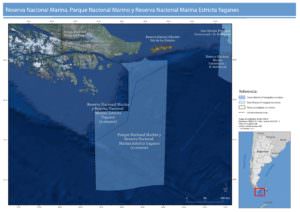Commercial fishing is an important revenue source for Argentina, and the industry’s interests are strong, but the government is committed to protecting at least 10 percent of its territorial waters by 2020. Although reconciling the need for Marine Protected Areas with the economic interests of the fishing industry can be challenging, Global Fishing Watch has proved to be an effective tool to facilitate negotiations amongst the different interested parties.
In October 2017, Argentina announced that it would create two marine protected areas covering a combined 98,000 square kilometers, with large no-take areas in the Southern Atlantic. “Global Fishing Watch was key in making this happen” said Maia Gutierrez from the movement “No Blue, No Green.”


The announcement followed months of technical debates and difficult negotiations that included intense lobbying by the fishing industry. “The lobby against the no-take MPAs was strong,” said Gutierrez, “in our country, fishing is an important business. They argued that there would be huge economic losses caused by the MPAs.”
To investigate these statements, the “No Blue, No Green” team turned to Global Fishing Watch. “We looked at the fishing activity within the future MPAs during 2016 and 2017,” said Martina Sasso, also from the “No Blue, No Green” movement, “and we discovered that very few vessels had fished in there.” The team overlayed the boundaries of the proposed MPAs into the Global Fishing Watch map and made a video that evidenced the reduced impact the MPAs would have for the fishing industry. This video was crucial to convincing key stakeholders to announce the creation of MPAs.
Video courtesy of Tompkins Conservation
“That was the tipping point,” said team member Lucila Masera. “It was evident that the future MPAs would have no real economic impact and that the fishing effort could be easily redistributed in areas with no specific protection.”
On the ecological side, the value and diversity of the area is supported by many years of research from scientists and NGOs from the Forum for the Conservation of the Patagonian Sea. The two new marine protected areas will comprise the 49,000 square kilometer Yaganes Marine National Park, which lies just south of the southern tip of Argentina, and the 29,000 square kilometer Namuncurá-Burdwood Bank II Marine National Park which is an expansion of an already existing MPA and lies about 500 Kilometers south of Falkland Islands (islas Malvinas).
The “No Blue, No Green” team intends to embed the Global Fishing Watch map into their website so that Argentinians can become more aware of the fishing activity within their waters and hold their government accountable for protecting the new MPAs.
The new MPA’s will significantly increase the protection of Argentina’s national waters. There will certainly will be more challenging debates ahead, as the country works to reach its goal of 10 percent by 2020. “Global Fishing Watch is a very powerful tool,” said Sasso. “This is only the beginning.”


